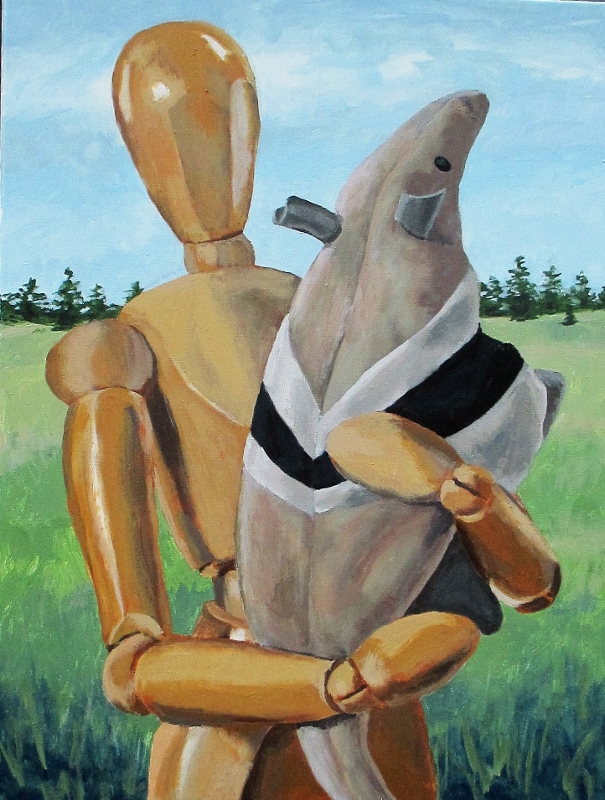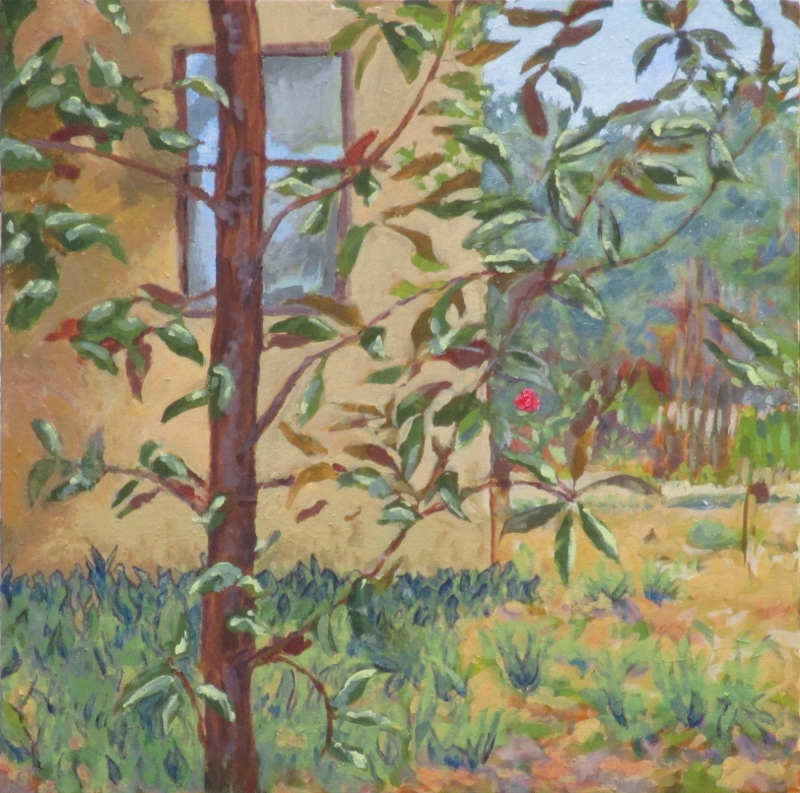| It took me months to “get around to” painting this image. Something inside me warned me against the playful subject. Another feature of the painting that concerned me was its treatment. It was necessary to paint it somewhat realistically, but I have been entertaining fantasies of flinging paint. I have other uncharacteristic paintings on deck. Am I being untrue to my artistic self? My friend and plein air partner Vicki says “If you don’t want to paint that way, they why do you? You can change.” And, you see, that is almost the right question. The right question is “Do I, perhaps, really want to paint this way?” And that question is unanswerable also because sometimes I do and sometimes I don’t. I think I do want to paint this way because it comes so naturally—at certain times and under certain circumstances. It feels absolutely right and that it would be stupid and arbitrary to force myself into a different direction—at those times and under those circumstances. |
So the real question for me is, “Why may I not paint like this sometimes and other ways at other times?” Or even in different ways in the same painting! (I do that.)
May I?
Yes! Yes I may, and I refuse to give anyone the right to censure me for it.
At our book club meeting one night the discussion turned to characterization, which in the novel in question we disparaged as flat. We saw only one aspect of a person.
Being me, I woke next morning thinking about painting and after a while about how different some of my paintings are from others. Sometimes when several of my works hang together, one might conclude that they were not all the work of the same artist.
I have heard more than once that it is important to present homogeneous art. I have found that to be difficult, because some ideas ask to be realized in one way, others in another.
Literati on the written arts: We don’t like flat, single aspect characters.
Gallery industry and other art pundits: We like uncomplicated, single aspect artists.
There have long been artists who incorporate multiple styles and levels of completion in a single painting. And what’s good enough for El Greco is good enough for me.
So please keep in mind that if an artist doesn’t employ one single treatment for every painting, it is quite likely that she* makes choices from among multiple capabilities, and the viewer has one more dimension of the artist’s character and message to enjoy.
*My solution to the indeterminate gender pronoun controversy is to default to the feminine. This is to signify that I have always viewed the use of “he” as implying nothing about gender politics, and choose now to view “she” in the same way. Since it does matter to some people, the truly even-minded writer should have no problem accommodating them. Those who cannot let go of the masculine bias really have no justification for it.
I find that the sprinkling of both gendered pronouns, supposedly equally throughout, shouts endorsement of gender politics—and what good does that do? In the same vein, I deplore the use of x, as in xe for s/he or any other solution that does not just graciously acknowledge that 2500 years of male dominance of pronouns is enough, and if we really believe it didn’t matter, it still shouldn’t.
You know what would be a truly lovely, loving solution? What if male writers used “she” exclusively and female writers used “he”?
May I?
Yes! Yes I may, and I refuse to give anyone the right to censure me for it.
At our book club meeting one night the discussion turned to characterization, which in the novel in question we disparaged as flat. We saw only one aspect of a person.
Being me, I woke next morning thinking about painting and after a while about how different some of my paintings are from others. Sometimes when several of my works hang together, one might conclude that they were not all the work of the same artist.
I have heard more than once that it is important to present homogeneous art. I have found that to be difficult, because some ideas ask to be realized in one way, others in another.
Literati on the written arts: We don’t like flat, single aspect characters.
Gallery industry and other art pundits: We like uncomplicated, single aspect artists.
There have long been artists who incorporate multiple styles and levels of completion in a single painting. And what’s good enough for El Greco is good enough for me.
So please keep in mind that if an artist doesn’t employ one single treatment for every painting, it is quite likely that she* makes choices from among multiple capabilities, and the viewer has one more dimension of the artist’s character and message to enjoy.
*My solution to the indeterminate gender pronoun controversy is to default to the feminine. This is to signify that I have always viewed the use of “he” as implying nothing about gender politics, and choose now to view “she” in the same way. Since it does matter to some people, the truly even-minded writer should have no problem accommodating them. Those who cannot let go of the masculine bias really have no justification for it.
I find that the sprinkling of both gendered pronouns, supposedly equally throughout, shouts endorsement of gender politics—and what good does that do? In the same vein, I deplore the use of x, as in xe for s/he or any other solution that does not just graciously acknowledge that 2500 years of male dominance of pronouns is enough, and if we really believe it didn’t matter, it still shouldn’t.
You know what would be a truly lovely, loving solution? What if male writers used “she” exclusively and female writers used “he”?


 RSS Feed
RSS Feed